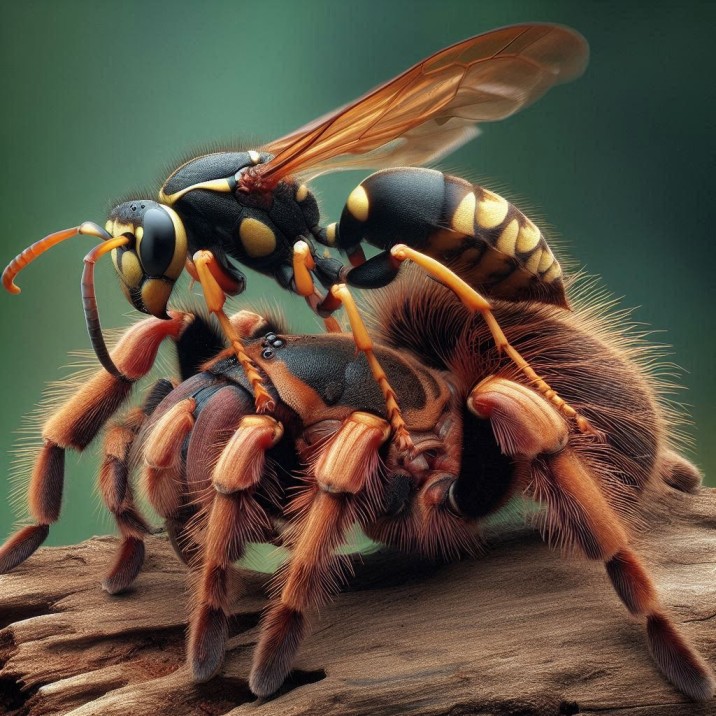What Are the Tarantula’s Deadliest Enemies?
Tarantulas are fascinating creatures, but even these fearsome spiders have enemies. In this article, we’ll explore the tarantula’s deadliest enemies, how these predators affect tarantulas, and what tarantulas do to defend themselves. We’ll also look at some surprising facts about these interactions in nature.

Table of Information
Table of Contents
| Enemy | Impact on Tarantula | Defense Mechanism |
|---|---|---|
| Tarantula Hawk Wasp | Paralysis and death | Camouflage, hiding |
| Birds | Prey on tarantulas | Burrowing, nocturnal habits |
| Small Mammals (e.g., mice) | Predation | Venomous bite |
| Humans | Habitat destruction | None effective |
| Fungi (e.g., Cordyceps) | Infection and death | Avoidance behaviors |
Introduction
Tarantulas are known for their large size, hairy bodies, and fearsome appearance. Despite their formidable look, tarantulas face many threats in their natural habitats. In this article, we’ll delve into the various predators and threats that pose a danger to these amazing spiders. By understanding these threats, we can appreciate the balance of nature and the challenges tarantulas must overcome to survive.
What Are the Tarantula’s Deadliest Enemies?
To answer this question “What Are the Tarantula’s Deadliest Enemies” we need to following points:
The Tarantula Hawk Wasp: A Fearsome Predator
The Tarantula Hawk Wasp is one of the most dangerous enemies of the tarantula. This wasp is not only bold but also has a unique hunting method that specifically targets tarantulas.
How the Tarantula Hawk Wasp Hunts
The female wasp hunts tarantulas by paralyzing them with a powerful sting. Once paralyzed, the wasp drags the tarantula to its burrow and lays an egg on it. When the egg hatches, the larva feeds on the still-living tarantula, consuming it from the inside out.
Tarantula’s Defense Mechanisms
Tarantulas use camouflage and hiding to avoid these wasps. They stay in their burrows and only come out at night to reduce the chance of encountering a wasp.
Birds: Aerial Predators
Many species of birds see tarantulas as a tasty meal. These birds have sharp vision and can spot tarantulas from high above.
Birds That Prey on Tarantulas
Hawks, owls, and other birds of prey often hunt tarantulas. They swoop down quickly, grabbing the tarantula with their sharp talons.
Tarantula’s Defense Mechanisms
To avoid birds, tarantulas often rely on burrowing and being nocturnal. By staying underground during the day and only emerging at night, they reduce the risk of being caught by birds.
Small Mammals: Unexpected Predators
Small mammals, such as mice and rats, also pose a threat to tarantulas. These mammals are opportunistic feeders and will eat a tarantula if given the chance.
How Small Mammals Hunt Tarantulas
These predators use their keen sense of smell to find tarantulas. They dig into burrows and attack the spiders, often eating them alive.
Tarantula’s Defense Mechanisms
Tarantulas defend themselves with their venomous bite. While not usually fatal to humans, this bite can be enough to deter or kill a small mammal.
Humans: The Most Dangerous Enemy
Humans pose one of the greatest threats to tarantulas through habitat destruction and the pet trade.
How Humans Impact Tarantulas
Deforestation and urbanization destroy the natural habitats of tarantulas, reducing their numbers. Additionally, capturing tarantulas for the pet trade also contributes to the decline in their populations.
Tarantula’s Defense Mechanisms
Unfortunately, tarantulas have no effective defense against humans. Conservation efforts are needed to protect these fascinating creatures.
Fungi: The Silent Killers
Certain types of fungi, like Cordyceps, can infect tarantulas and eventually kill them.
How Fungi Infect Tarantulas
These fungi release spores that land on the tarantula. The spores grow into the tarantula’s body, consuming it and eventually killing it.
Tarantula’s Defense Mechanisms
Tarantulas exhibit avoidance behaviors to try and escape infected areas, but there’s no guaranteed way to avoid these deadly fungi.
Conclusion
Tarantulas face many enemies in the wild, from wasps and birds to small mammals, humans, and even fungi. Each predator uses different methods to hunt tarantulas, and tarantulas have developed unique ways to defend themselves. Understanding these interactions helps us appreciate the complexities of nature and the survival challenges tarantulas must navigate.
FAQs about What Are the Tarantula’s Deadliest Enemies
- What is the most dangerous predator for tarantulas? The Tarantula Hawk Wasp is considered one of the most dangerous predators due to its method of paralyzing and using tarantulas as living food for its larvae.
- How do birds hunt tarantulas? Birds like hawks and owls hunt tarantulas by spotting them from the air and swooping down to grab them with their sharp talons.
- Can tarantulas defend themselves against small mammals? Yes, tarantulas use their venomous bite to defend themselves against small mammals like mice and rats.
- How do humans pose a threat to tarantulas? Humans threaten tarantulas through habitat destruction and capturing them for the pet trade, reducing their natural populations.
- What kind of fungi can infect tarantulas? Fungi like Cordyceps can infect tarantulas, growing inside them and eventually killing them.

